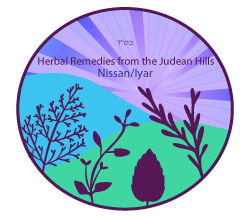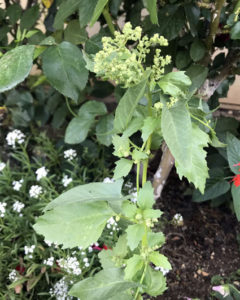Herbal Remedies from the Judean Hills
כף אווז לבן – Lamb’s Quarters – Chenopodium Album
Printable Version
G-d-Given Most Nutritious Edible Weed
Lamb’s quarters is a G-d given, delicious, leafy green, herb replete with edible seeds, available even when other greens have grown too big, old, tough and stringy. Whereas the beginning of summer is a challenging time for foragers, who forage for food rather than medicine, lamb’s quarters is one of the very few edible herbs that lasts into the summer. It certainly qualifies as the food Hashem originally granted us humans:
“G-d said, ‘Behold, I have given you every seed bearing herb, which is upon the surface of the entire earth, and every tree that has seed bearing fruit; it will be yours for food” (Bereishit 1:28)
Lamb’s quarters grows just about anywhere, especially on roadsides, streambanks, gardens, lawns, and along the fringes of fields and banks. It is one of our most enduring annual weeds producing a tremendous amount of seeds that can survive dormant in the soil for decades. Lamb’s quarters is a freebie that we should all know about, for we can find it from north to south, east to west from late spring until frost. Many people see lamb’s quarters as nothing more than a common weed, never realizing that this tasty and nutritious green vegetable can be enjoyed, free for the picking.
“What is a weed? A plant whose virtues have not yet been discovered.” – Ralph Waldo Emerson
Following amaranth, lamb’s quarter ranks second highest in nutrition of all wild foods. It is like a super-spinach, significantly higher than spinach in many nutrients, including calcium, phosphorus, Vitamins C and A, minerals and proteins. Use the tender young leaves raw in salad and steam the tougher leaves adding olive oil and sea salt.
The Green Seeker’s Gift
As it gets warmer and the green landscape of the Middle East begins to yellow, I must look harder for green supplies for my daily green smoothie. I become a persevering ‘green seeker’ like the description in the book of Job:
ספר איוב פרק לט פסוק ח יְתוּר הָרִים מִרְעֵהוּ וְאַחַר כָּל יָרוֹק יִדְרוֹשׁ :
“The range of the mountains is his pasture, and he searches after every green thing” (Iyov 39:8).
THE RANGE OF THE MOUNTAIN …This is his pasture. He SEARCHES to find something that is green to feed him and that is good for him (Malbim, Iyuv 39:8).
The odorless, branching, annual lamb’s quarters with diamond-shaped leaves and a whitish coating on their underside on a square stem is indeed a find. Lamb’s quarters flowers are tiny and green, and they bloom in clusters. Flowers change to tiny fruits with even tinier black seeds. The Hebrew name for lamb’s quarters reflects the Latin name Chenopodium deriving from the words ‘cheno,’ meaning goose, and ‘podium,’ meaning foot. It received this name because of the resemblance of the toothed lamb’s quarters leaves to geese feet. Although its nickname ‘wild spinach’ makes sense, I don’t know why it is called lamb’s quarters or pigweed. Beware of caterpillars, which eat lamb’s quarters leaves and hide underneath for protection. The red tracing in the leaf in the lower right corner is a sign of larvae.
Medicinal Uses of Lamb’s Quarters
Lamb’s quarters is better known as a nutritious food-plant rather than a medicine. However, various native North American tribes used it both as a food source and herbal medicine. As a cooked vegetable, it was used for its overall health benefits treating nutritional deficiencies, and as a preventive for scurvy. A decoction was used traditionally to improve the blood, and as an herbal remedy for rheumatic pains, gout and colic. When cooking beans, leaves and stems of lamb’s quarters were added to reduce gas caused by the beans. Due to its refrigerant properties, the leaves reduce inflammation and the accompanying pain. The green leaves when eaten in their fresh raw state are particularly beneficial for healing anemia, since they are rich in iron. Therefore, they help to increase blood cell count and overall vitality of the circulatory system. A tea of the leaves is beneficial for diarrhea, internal inflammation, stomachaches, and loss of appetite. The tea can also be used as a wash to heal skin irritations and other external complaints such as insect stings, bites and eczema. Soaking the body in bathwater with lamb’s quarters tea supports skin health by toning and tightening the tissues. Furthermore, wraps or a poultice from the leaves soothe burns. It has recently been confirmed that lamb’s quarters can have a positive effect on chronic wounds and that it has a mild laxative effect. The greens and seeds have significant antioxidant capacity for eliminating unwanted free radicals in the body.
Nutritional Profile of Lamb’s Quarters
Lamb’s quarters is exceptionally nutritious. Our bodies can produce fourteen of the essential amino acids, but eight of them need to be found in external sources. Lamb’s quarters is one of those valuable sources. It is very high in vitamin A, calcium, potassium, and phosphorus and is a good source of protein, trace minerals, B-complex vitamins, vitamin C, iron, and fiber. It is richer in vitamin C than spinach, and far richer in vitamin A. Though not quite so rich in iron and potassium, is still a good source of these minerals. Seeds are high in protein, calcium, phosphorus, potassium, and niacin.
|
Nutrients (Per
|
||
|
Calories – 43
|
Niacin – 1.2 mg.
|
Thiamin – 0.16 mg.
|
|
Calcium – 309 mg.
|
Phosphorus – 72 mg.
|
Vitamin A – 11,600 IU
|
|
Fat –
|
Protein –
|
Vitamin C – 80 mg.
|
|
Iron – 1.2 mg.
|
Riboflavin – 0.44 mg.
|
Fiber
|
Picking Lamb’s Quarters
When you learn to identify lamb’s quarters, don’t be surprised to find it growing all around you.
Forage for wild lambs quarters around your landscape or allow a few plants to grow in your vegetable and herb garden. Collect the young tender plants whole, and then when the stems become tough, collect just the leaves and tender tips. The flowers are also edible, and so are the seeds. To harvest lambs quarters just cut or snap off the youngest and best looking branches from the top and sides of the plant.
Culinary Uses
Prepare your lamb’s quarters the same way you use spinach. Experiment by substituting lamb’s quarters for spinach or chard in some of your favorite recipes. Enjoy the young leaves and smaller stems raw in salads or cooked as a vegetable. Once you steam a batch of the fresh leaves and stems the biggest surprise may be just how much you enjoy the taste of this plant that you previously yanked from the garden and discarded. It tastes a lot like spinach, only milder, with sort of a hint of peapods. You can add both whole or ground seeds to bread, making a heartier, darker bread, the seeds acting like poppy-seeds. You can also sprout the seeds. They produce a very delicate, reddish-brown sprout, good in salads or cooked very briefly in stir-fries.
Hand’s On
When cooking lamb’s quarters the easiest preparation is to simply steam the leaves and stems in a small amount of water until tender. The greens will cook very quickly and turn a dark green color. The cooked greens are delicious just as they are with no additional seasoning or flavoring necessary. If you wash them really thoroughly before cooking, it will remove a lot of the grainy texture.
Lamb’s Quarter Sunflower Dip
This dip is so simple and delicious. I make it in no time almost every week for Shabbat.
2 cups shelled sunflower seeds
2 cloves garlic
1 cup lamb’s quarters
¼ cup olive oil
Sea salt to taste
Process everything in food-processor until smooth (you may dilute with water for a softer dip)
Lamb’s Quarters Spread
Serve with Shabbat challah or as a spread on a healthy sandwich
2 cloves garlic
1 small red onion
3 cups lamb’s quarters leaves
1 ripe avocado
½ cup toasted nuts (I use walnuts or almonds)
1/3 cup olives
2 tablespoons miso
1 teaspoon cayenne pepper or to taste
1. Process the onion and garlic in food processor
2. Add the remaining ingredients and process until finely chopped or smooth
Makes 2 ½ Cups
Lamb’s Quarters Quiche
Choose between dairy or vegan option
1 9 inch unbaked pie crust
4 cups young lamb’s quarter leaves, cut up
3 eggs
1 ¾ cups milk of your choice (rice or almond milk for vegan option)
¼ cup chopped onion
2 cups grated Swiss cheese (may omit for vegan choice)
2 tablespoons olive oil or butter
1 tablespoon flour or ground flax seeds
½ teaspoon sea salt
1. Partially bake piecrust at 450F (230C) for 5-7 minutes or until light brown. Reduce heat to 325F (160C).
2. Cook onion until tender and limp. Stir in flour and salt.
3. Beat together eggs and milk.
4. Sprinkle cheese in pie shell; pour in eggs.
5. Add leaves and vegetables.
6. Bake 40 to 45 minutes or until knife comes out clean when it’s inserted off center.
7. Let stand 10 minutes before serving.
https://www.berotbatayin.org
http://www.voices-magazine.com/#
http://www.voices-magazine.com/#


